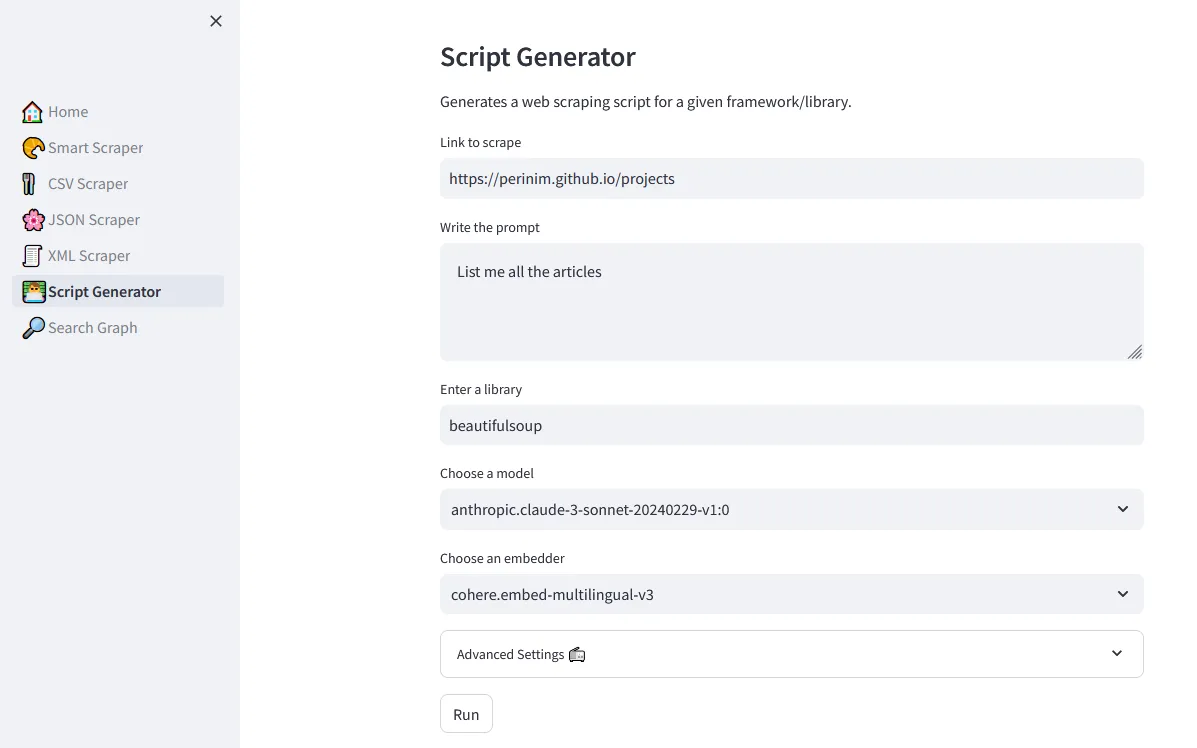Scrape All Things: AI-powered web scraping with ScrapeGraphAI 🕷️ and Amazon Bedrock ⛰️
Learn how to extract information from documents and websites using natural language prompts.
"In the beginning was a graph..." ― Greg Egan, Schild's Ladder
1
2
3
4
5
6
7
8
9
10
11
12
13
14
15
16
17
18
19
20
21
22
23
24
25
26
27
28
29
30
31
32
33
34
35
36
37
38
39
40
41
42
43
44
45
46
47
48
49
50
51
52
53
54
55
56
57
58
59
60
61
62
63
64
65
66
67
68
69
70
71
72
73
74
75
76
77
78
79
80
81
82
83
84
85
86
87
88
89
90
91
92
93
94
95
96
97
98
99
100
101
102
103
104
105
106
107
108
109
110
111
112
113
114
115
116
117
118
119
120
<catalog>
<book id="bk101">
<author>Gambardella, Matthew</author>
<title>XML Developer's Guide</title>
<genre>Computer</genre>
<price>44.95</price>
<publish_date>2000-10-01</publish_date>
<description>An in-depth look at creating applications
with XML.</description>
</book>
<book id="bk102">
<author>Ralls, Kim</author>
<title>Midnight Rain</title>
<genre>Fantasy</genre>
<price>5.95</price>
<publish_date>2000-12-16</publish_date>
<description>A former architect battles corporate zombies,
an evil sorceress, and her own childhood to become queen
of the world.</description>
</book>
<book id="bk103">
<author>Corets, Eva</author>
<title>Maeve Ascendant</title>
<genre>Fantasy</genre>
<price>5.95</price>
<publish_date>2000-11-17</publish_date>
<description>After the collapse of a nanotechnology
society in England, the young survivors lay the
foundation for a new society.</description>
</book>
<book id="bk104">
<author>Corets, Eva</author>
<title>Oberon's Legacy</title>
<genre>Fantasy</genre>
<price>5.95</price>
<publish_date>2001-03-10</publish_date>
<description>In post-apocalypse England, the mysterious
agent known only as Oberon helps to create a new life
for the inhabitants of London. Sequel to Maeve
Ascendant.</description>
</book>
<book id="bk105">
<author>Corets, Eva</author>
<title>The Sundered Grail</title>
<genre>Fantasy</genre>
<price>5.95</price>
<publish_date>2001-09-10</publish_date>
<description>The two daughters of Maeve, half-sisters,
battle one another for control of England. Sequel to
Oberon's Legacy.</description>
</book>
<book id="bk106">
<author>Randall, Cynthia</author>
<title>Lover Birds</title>
<genre>Romance</genre>
<price>4.95</price>
<publish_date>2000-09-02</publish_date>
<description>When Carla meets Paul at an ornithology
conference, tempers fly as feathers get ruffled.</description>
</book>
<book id="bk107">
<author>Thurman, Paula</author>
<title>Splish Splash</title>
<genre>Romance</genre>
<price>4.95</price>
<publish_date>2000-11-02</publish_date>
<description>A deep sea diver finds true love twenty
thousand leagues beneath the sea.</description>
</book>
<book id="bk108">
<author>Knorr, Stefan</author>
<title>Creepy Crawlies</title>
<genre>Horror</genre>
<price>4.95</price>
<publish_date>2000-12-06</publish_date>
<description>An anthology of horror stories about roaches,
centipedes, scorpions and other insects.</description>
</book>
<book id="bk109">
<author>Kress, Peter</author>
<title>Paradox Lost</title>
<genre>Science Fiction</genre>
<price>6.95</price>
<publish_date>2000-11-02</publish_date>
<description>After an inadvertant trip through a Heisenberg
Uncertainty Device, James Salway discovers the problems
of being quantum.</description>
</book>
<book id="bk110">
<author>O'Brien, Tim</author>
<title>Microsoft .NET: The Programming Bible</title>
<genre>Computer</genre>
<price>36.95</price>
<publish_date>2000-12-09</publish_date>
<description>Microsoft's .NET initiative is explored in
detail in this deep programmer's reference.</description>
</book>
<book id="bk111">
<author>O'Brien, Tim</author>
<title>MSXML3: A Comprehensive Guide</title>
<genre>Computer</genre>
<price>36.95</price>
<publish_date>2000-12-01</publish_date>
<description>The Microsoft MSXML3 parser is covered in
detail, with attention to XML DOM interfaces, XSLT processing,
SAX and more.</description>
</book>
<book id="bk112">
<author>Galos, Mike</author>
<title>Visual Studio 7: A Comprehensive Guide</title>
<genre>Computer</genre>
<price>49.95</price>
<publish_date>2001-04-16</publish_date>
<description>Microsoft Visual Studio 7 is explored in depth,
looking at how Visual Basic, Visual C++, C#, and ASP+ are
integrated into a comprehensive development
environment.</description>
</book>
</catalog>1
2
3
4
5
6
7
8
9
10
11
12
13
14
15
16
17
18
19
20
21
22
23
24
25
26
27
28
"""
Old XML scraper 👴🏻
"""
import json
from lxml import etree
# Get catalog (root element)
catalog = etree.parse('books.xml').getroot()
# Find all books
books = catalog.findall('book')
# Get author, title and genre for each book
result = {'books': []}
for book in books:
author, title, genre = book.find('author'), \
book.find('title'), \
book.find('genre')
result['books'].append({
'author': author.text,
'title': title.text,
'genre': genre.text
})
# Print the final result
print(json.dumps(result, indent=4))
1
2
3
4
5
6
7
8
9
10
11
12
13
14
15
16
17
18
19
20
21
22
23
24
25
26
27
28
29
30
31
32
33
34
35
36
37
38
39
40
41
42
43
44
45
46
47
48
49
50
51
52
53
54
55
56
57
58
59
60
61
62
63
64
{
"books": [
{
"author": "Gambardella, Matthew",
"title": "XML Developer's Guide",
"genre": "Computer"
},
{
"author": "Ralls, Kim",
"title": "Midnight Rain",
"genre": "Fantasy"
},
{
"author": "Corets, Eva",
"title": "Maeve Ascendant",
"genre": "Fantasy"
},
{
"author": "Corets, Eva",
"title": "Oberon's Legacy",
"genre": "Fantasy"
},
{
"author": "Corets, Eva",
"title": "The Sundered Grail",
"genre": "Fantasy"
},
{
"author": "Randall, Cynthia",
"title": "Lover Birds",
"genre": "Romance"
},
{
"author": "Thurman, Paula",
"title": "Splish Splash",
"genre": "Romance"
},
{
"author": "Knorr, Stefan",
"title": "Creepy Crawlies",
"genre": "Horror"
},
{
"author": "Kress, Peter",
"title": "Paradox Lost",
"genre": "Science Fiction"
},
{
"author": "O'Brien, Tim",
"title": "Microsoft .NET: The Programming Bible",
"genre": "Computer"
},
{
"author": "O'Brien, Tim",
"title": "MSXML3: A Comprehensive Guide",
"genre": "Computer"
},
{
"author": "Galos, Mike",
"title": "Visual Studio 7: A Comprehensive Guide",
"genre": "Computer"
}
]
}book element 📗, which contains children elements corresponding to the author, title and genre of the book, and that all books are themselves children nodes of the root node, which is called catalog 🗂️.Not-So-Fun Fact: in a past life, when I worked as a software tester, I used to write scripts like this all the time using frameworks like BeautifulSoup (BS will make an appearance later in this article, just keep reading) and Selenium. Glad those days are over! 🤭

1
2
3
4
5
6
7
8
9
10
11
12
13
14
15
16
17
18
19
20
21
22
23
24
25
26
27
28
"""
New XML scraper 🕷️⛰️
"""
import json
from scrapegraphai.graphs import XMLScraperGraph
# Read XML file
with open("books.xml", 'r', encoding="utf-8") as file:
source = file.read()
# Define the graph configuration
graph_config = {
"llm": {"model": "bedrock/anthropic.claude-3-sonnet-20240229-v1:0"},
"embeddings": {"model": "bedrock/cohere.embed-multilingual-v3"}
}
# Create a graph instance and run it
graph = XMLScraperGraph(
prompt="List me all the authors, title and genres of the books. Skip the preamble.",
source=source,
config=graph_config
)
result = graph.run()
# Print the final result
print(json.dumps(result, indent=4))
Skip the preamble instruction to ensure that Claude goes straight to the point and generates the right output.Input → 🟢 → 🟡 → 🟣 → Output.XMLScraperGraph, which we used in the example above, or the SmartScraperGraph (pictured below), and the possibility to create your own custom graphs.
AWS_*) but we can create a custom client and pass it along to the graph:1
2
3
4
5
6
7
8
9
10
11
12
13
14
15
16
17
18
19
20
21
22
23
24
25
26
27
28
29
30
31
32
33
34
35
36
37
38
39
40
41
42
43
44
45
"""
SmartScraperGraph with custom AWS client ☁️
"""
import os
import json
import boto3
from scrapegraphai.graphs import SmartScraperGraph
# Initialize session
session = boto3.Session(
aws_access_key_id=os.environ.get("AWS_ACCESS_KEY_ID"),
aws_secret_access_key=os.environ.get("AWS_SECRET_ACCESS_KEY"),
aws_session_token=os.environ.get("AWS_SESSION_TOKEN"),
region_name=os.environ.get("AWS_DEFAULT_REGION")
)
# Initialize client
client = session.client("bedrock-runtime")
# Define graph configuration
config = {
"llm": {
"client": client,
"model": "bedrock/anthropic.claude-3-sonnet-20240229-v1:0",
"temperature": 0.0
},
"embeddings": {
"client": client,
"model": "bedrock/cohere.embed-multilingual-v3",
},
}
# Create graph instance and run it
graph = SmartScraperGraph(
prompt="List me all the articles.",
source="https://perinim.github.io/projects",
config=config
)
result = graph.run()
# Print the final result
print(json.dumps(result, indent=4))
1
2
3
4
5
6
7
8
{
"articles": [
"Rotary Pendulum RL",
"DQN Implementation from scratch",
"Multi Agents HAED",
"Wireless ESC for Modular Drones"
]
}👨💻 All code and documentation is available on GitHub.
1
2
git clone https://github.com/JGalego/ScrapeGraphAI-Bedrock
cd ScrapeGraphAI-Bedrock1
2
3
4
5
6
7
8
9
10
# Install Python packages
pip install -r requirements.txt
# Install browsers
# https://playwright.dev/python/docs/browsers#install-browsers
playwright install
# Install system dependencies
# https://playwright.dev/python/docs/browsers#install-system-dependencies
playwright install-deps1
2
3
4
5
6
7
8
# Option 1: (recommended) AWS CLI
aws configure
# Option 2: environment variables
export AWS_ACCESS_KEY_ID=...
export AWS_SECRET_ACCESS_KEY=...
export AWS_SESSION_TOKEN=...
export AWS_DEFAULT_REGION=...1
2
3
4
5
# Run the full application
streamlit run pages/scrapegraphai_bedrock.py
# or just a single demo
streamlit run pages/smart_scraper.pyScriptCreatorGraph, to generate an old-style scraping pipeline powered by the beautifulsoup framework or any other scraping library.
1
2
3
4
5
6
7
8
9
10
11
12
from bs4 import BeautifulSoup
import requests
url = "https://perinim.github.io/projects"
response = requests.get(url)
soup = BeautifulSoup(response.content, "html.parser")
articles = soup.find_all("article")
for article in articles:
print(article.get_text())👷♂️ Want to contribute? Feel free to open an issue or a pull request!
Any opinions in this post are those of the individual author and may not reflect the opinions of AWS.
